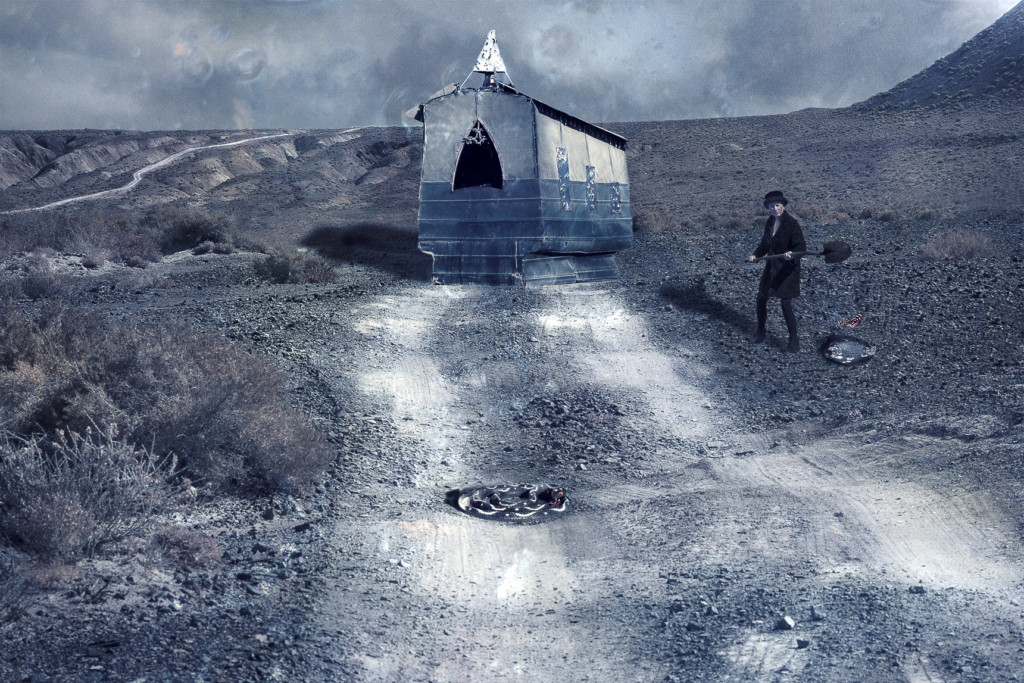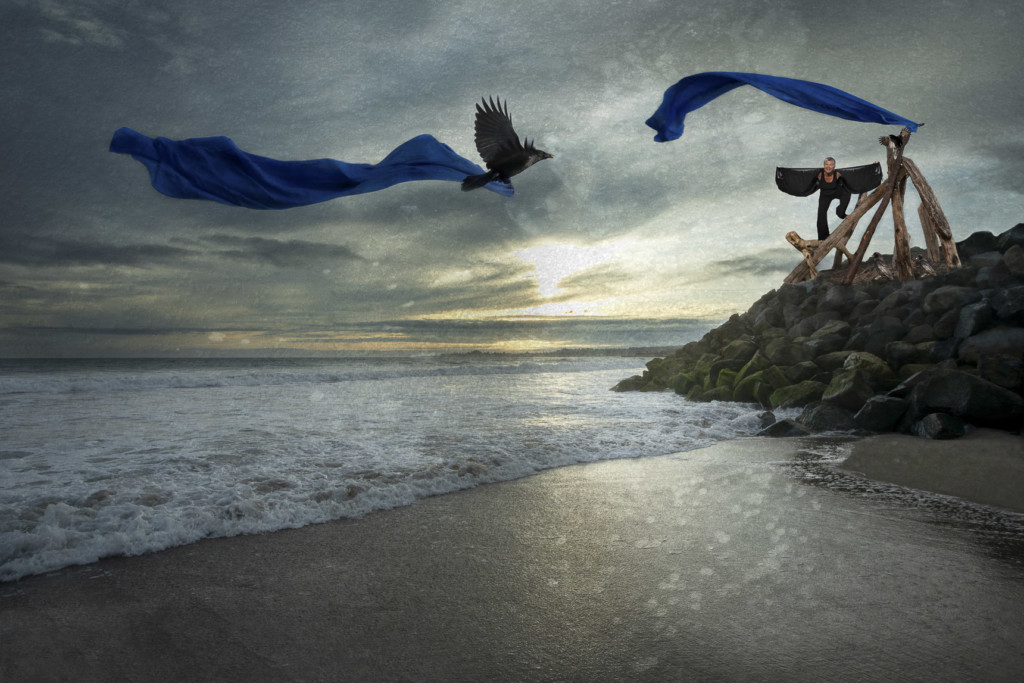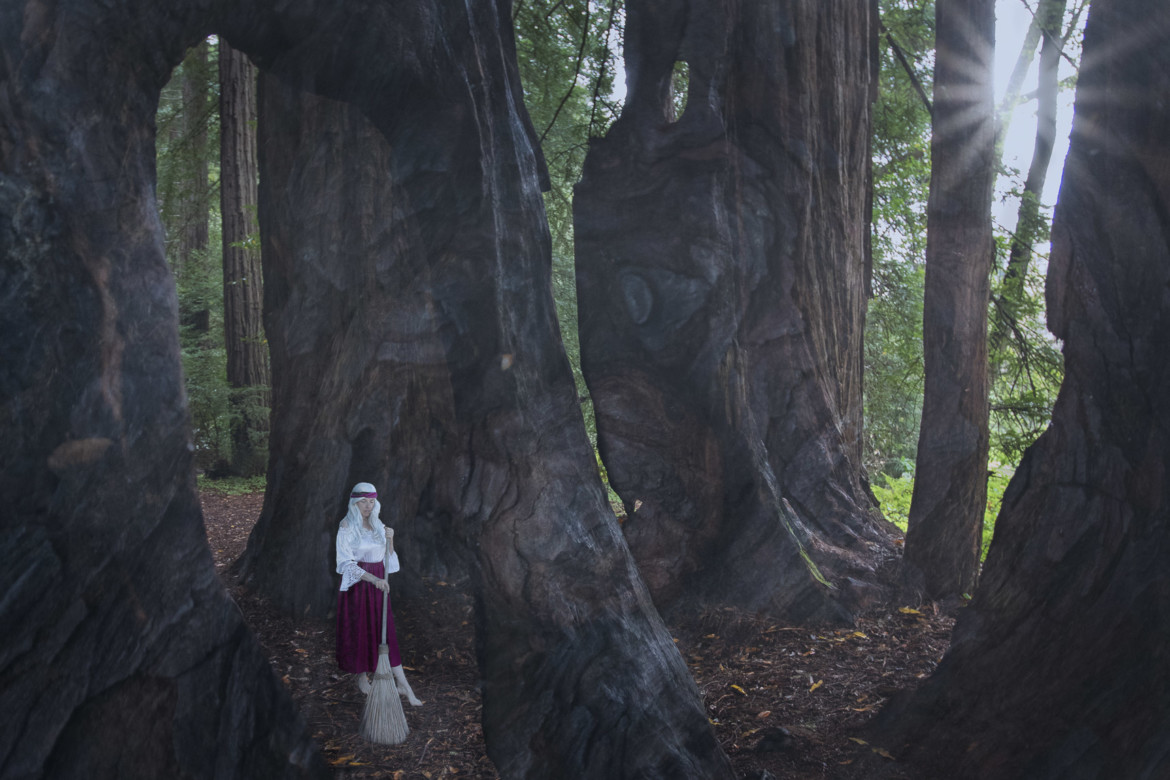By Greta Chiocchetti
At the end of a dirt path, there’s a small house, positioned against a gray, overcast sky and lonely desert hills behind it. It’s not your typical brick-and-mortar abode; rather, it resembles a tent, with walls made of fabric tightly stretched across its frame. In front, a triangular hole serves as a window, revealing a chandelier hanging inside.
In front of the mysterious structure, a snake with piercing red eyes is coiled up on the ground, flicking its tongue menacingly as if ready to strike at any moment. To the right, a woman clad in all black and a top hat is busy shoveling, revealing a cistern from which a lone butterfly emerges.
If the scene sounds dreamlike, it’s because it is—the surreal setting is photographer Kay Bermender’s “Memory, Interrupted,” a reimagining of a vision that came in a dream. Bermender, an M.A. student at Academy of Art University’s School of Photography (PH), created the photomontage art piece as a part of her thesis project “Liminal Space: Where the Conscious and Unconscious Meet to Dance,” an otherworldly series inspired by real dreams shared with her by real women. Last fall, the photo was selected to exhibit at the PhotoPlace Gallery in Middlebury, Vermont, as a part of its “Photomontage: Constructed Reality” display. It was also part of a PhotoAlliance online exhibition.
“I don’t have a background in psychology, but I’ve been really diving into Jungian psychology as a part of this process,” said Bermender, who was inspired to take on the project after tracking her own dreams in a dream journal.

Her work focuses on the dreams of menopausal or perimenopausal subjects, who are often overlooked by our youth-obsessed society. “From a hormonal standpoint and personality standpoint, it tends to be as turbulent a time as adolescence. For a lot of women, there are huge transitions, whether it’s your kids going off to school and you’re becoming an empty nester or your parents are passing away or you’re dealing with parental illnesses,” she said. “There tends to be a lot of foundational shake-ups that are happening, and women at that time tend to be really ripe for processing through their dreams and going into states where they’re dealing with a lot of archetypal energy.”
Photomontage, Bermender’s medium of choice, is the meticulous process of overlapping two or more photographs to create a new, seamless image. For Bermender, it’s an opportunity to bring unconscious messages into the conscious world.
“Creating photomontage is much more than a mechanical process. Rather, creating photomontage is expressing a personal vision or story in a unique way. The outcome is often one with an element of surprise, beauty, or unfinished story,” said photographer Tom Chambers, who was the juror that selected Bermender’s photograph for the exhibition.
In “Memory, Interrupted,” Bermender renewed a dream about finding one’s way home. In it, the subject was struggling to overcome an obstacle in her path—represented as the sinister snake blocking the entrance to the house—but ultimately took a different route and stumbled upon an unexpected treasure.
“It was the treasure that really stuck with me, the unexpected payoff of the long journey home,” said Bermender, who served as the model in the shot. “The butterflies coming out of the cistern, which has all of the light of the world reflecting out of it, came to me as a metaphorical choice for the actual treasure chest.”
Bermender’s process, which involves interviewing women and working with them to find visually-striking—and doable—representations of their unreal dreams, requires a lot of pre-planning.
“We try to map the essence of the dream because some elements are just not possible to translate literally. There was one woman who had a dream about a llama in the snow, and I was like, ‘Okay, that might be beyond my ability right now,’” said Bermender. “It’s very collaborative; we talk about locations and props, and if it’s a portrait—I’m doing a lot of self-portraits right now during COVID—they’ll think about how they want to represent themselves with the style of dress.”

Once Bermender visualizes a concept, there’s the task of photographing each of the elements individually, keeping in mind that each photo must be believable once pasted together.
“I really have to keep in mind that the quality of light and shadows and even the angles that the photos are taken have to be compatible,” said Bermender. “But there’s also just this point where the art kind of takes its own turn, and I start to discover how all the elements interact with each other. From there it’s really instinctual.”
“Liminal Space” went through a period of refinement over the last two semesters at the Academy, which Bermender says prepared her to submit her work for exhibition.
“Through my thesis classes, I really worked and reworked my artist’s statement, just trying to pin down exactly what it was that I wanted to say and what I wanted my project to say,” said Bermender. “But the process of submitting for Spring Show was actually very similar to submitting to galleries, and it really helped that I already had that experience and had built up that confidence.”
In PH 674: Portfolio: Capture & Critique, Bermender worked closely with PH Associate Online Director James David Goins, whose concrete feedback helped her solidify her project.
“She would consistently go back and make adjustments, sorting out what did and did not work. Self-editing is such a critical element for photographers; her discernment as to what images to leave in or out of the series was an integral part of creating a series of images that effectively provided a clear and thoughtful narrative,” said Goins in an email. “Kay was deliberate and intentional with her creative decisions, which resulted in a unified body of work.”
